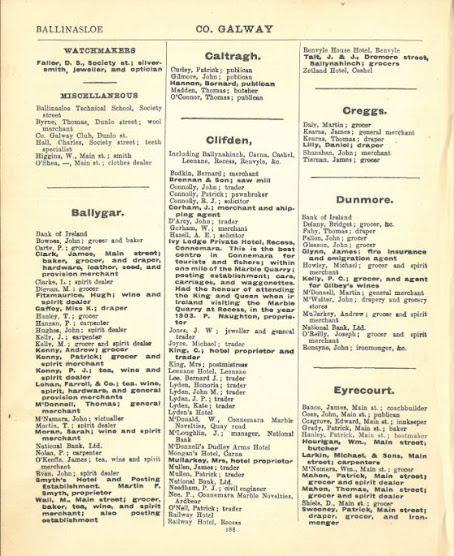Trades and businesses in early 20th century
Ireland
This month, as many of our business are fighting hard to
maintain their customers through online and take-way trading, we take a look at
some of the businesses that existed in towns around Ireland on the eve of
WWI. The Dublin, Leinster and Connaught
Trades’ Directory was published in 1912, under the imprint of the Trades’
Directories company, based in Edinburgh and Birmingham. It includes 227 pages
of county-by-county detail of businesses in cities, towns and villages in those
parts of Ireland. It provides a snap shot of the types of trading activity that
went on all around the country at that time. Over 100 years later, we can see
that some of these enterprises are still with us while others, due to the
passage of time or changes in fashion or technology, no longer have relevance.
This page from the County Galway
part of the directory shows how even a relatively small village like Ballygar,
close to the border with County Roscommon, was a hub for trading and commerce at
a time when many people didn’t have the funds or means to travel much beyond
their local area. We can see that Clifden, then as now, had a thriving set of
businesses. In 1912, the town would have been celebrating the centenary of its
foundation by John D’arcy in 1812.
The directory also contains a gazetteer of Ireland, with place names arranged alphabetically. The entries indicate the place’s proximity to post office and railway stations, a vital element of commerce in early 20th century Ireland. The gazetteer includes a map of all railways in Ireland, at a time when railway construction had reached its height. This section of the map shows the northern area of the country, which now only has one mail line travelling from Dublin to Belfast and onwards to Derry. We can see from this map that the area was formerly exceptionally well connected by rail. Details of steamer and shipping connections to other parts of the world are also included.
The library holds many other examples of printed trade directories and gazetteers, going back to Pigot’s Trade Directory from 1824. In addition online access to others is available through our subscription to the Find My Past database as well as free digital resources such as the Internet Archive. Special Collections at the University of Leicester library has created a digital repository of trade directories for England and Wales covering the period from the mid-18th century up to 1910, see while the Shane Wilson Info page includes links to many historical directories.



Comments